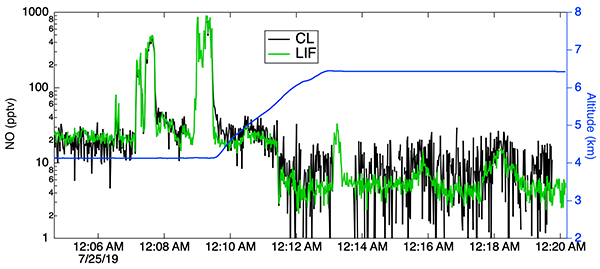Atmospheric Composition & Chemical Processes: Instruments
Laser Induced Fluorescence Instrumentation for Nitric Oxide (NO-LIF)

Nitrogen oxides are key species controlling many aspects of atmospheric radical chemistry throughout the atmosphere. The recent development in CSL of a single-photon laser induced fluorescence (LIF) technique for measuring nitric oxide (NO) has been demonstrated to provide the best currently available measurement of NO (lowest detection limit and uncertainty) while reducing some aspects of experimental effort compared to the more common chemiluminescence instrumentation. The new technique is anticipated to allow for better understanding of radical chemistry in very low-NO environments characteristic of much of the troposphere.
The existing instrument was designed for 19" rack-type integration on platforms such as the NASA DC-8. This instrument has two channels that can be used for simultaneous detection of NO and NO2 or NOy by using a photolytic or catalytic inlet converter. Ongoing work in our laboratory seeks to develop a version of this instrument by which NO2 is photolyzed to NO within the NO-LIF cell, thereby eliminating the need for an inlet converter for NO2 measurement. The use of the instrument to quantify isotopic ratios of NO is also currently being tested.

- Detection limit: 1 pptv / 1 second
- Accuracy: +/- 9%
- Airborne time response: 5 Hz
- Atmospheric Emissions and Reactions Observed from Megacities to Marine Areas (AEROMMA) 2023, NASA DC-8
- Bermuda boundary Layer Experiment on the Atmospheric Chemistry of Halogens (BLEACH) 2022, BIOS Tudor Hill Marine Atmospheric Observatory
- Stratospheric Aerosol processes, Budget and Radiative Effects (SABRE) 2022, NASA WB-57
- Asian Summer Monsoon Chemical & CLimate Impact Project (ACCLIP) 2021, NASA WB-57
- Fire Influence on Regional to Global Environments and Air Quality (FIREX-AQ) 2019, NASA DC-8
- Southwest Urban NOx and VOC Experiment (SUNVEx) 2021, Mobile Lab
- Volatile organic compound Emissions and Reactive Nitrogen from Northern Active Layers (VERNNAL) 2025, NOAA Chemical Sciences Laboratory
Rollins, A. W., Rickly, P. S., Gao, R.-S., Ryerson, T. B., Brown, S. S., Peischl, J., and Bourgeois, I., Single-photon laser-induced fluorescence detection of nitric oxide and sub-parts-per-trillion mixing ratios, Atmospheric Measurement Techniques, doi:10.5194/amt-13-2425-2020, 2020.